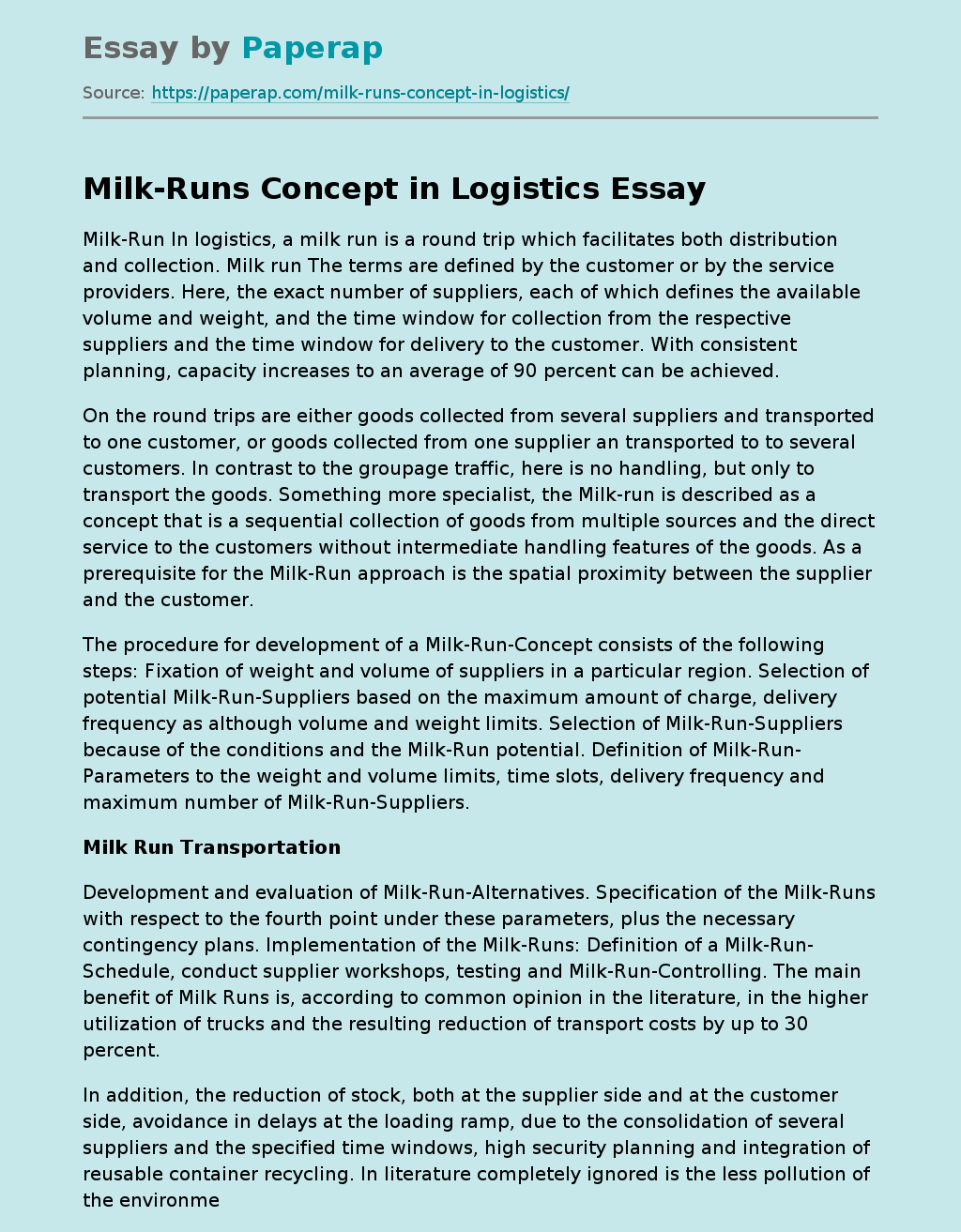Milk-Run In logistics, a milk run is a round trip which facilitates both distribution and collection. Milk run The terms are defined by the customer or by the service providers. Here, the exact number of suppliers, each of which defines the available volume and weight, and the time window for collection from the respective suppliers and the time window for delivery to the customer. With consistent planning, capacity increases to an average of 90 percent can be achieved.
On the round trips are either goods collected from several suppliers and transported to one customer, or goods collected from one supplier an transported to to several customers.
In contrast to the groupage traffic, here is no handling, but only to transport the goods. Something more specialist, the Milk-run is described as a concept that is a sequential collection of goods from multiple sources and the direct service to the customers without intermediate handling features of the goods. As a prerequisite for the Milk-Run approach is the spatial proximity between the supplier and the customer.
The procedure for development of a Milk-Run-Concept consists of the following steps: Fixation of weight and volume of suppliers in a particular region. Selection of potential Milk-Run-Suppliers based on the maximum amount of charge, delivery frequency as although volume and weight limits. Selection of Milk-Run-Suppliers because of the conditions and the Milk-Run potential. Definition of Milk-Run-Parameters to the weight and volume limits, time slots, delivery frequency and maximum number of Milk-Run-Suppliers.
Milk Run Transportation
Development and evaluation of Milk-Run-Alternatives.
Specification of the Milk-Runs with respect to the fourth point under these parameters, plus the necessary contingency plans. Implementation of the Milk-Runs: Definition of a Milk-Run-Schedule, conduct supplier workshops, testing and Milk-Run-Controlling. The main benefit of Milk Runs is, according to common opinion in the literature, in the higher utilization of trucks and the resulting reduction of transport costs by up to 30 percent.
In addition, the reduction of stock, both at the supplier side and at the customer side, avoidance in delays at the loading ramp, due to the consolidation of several suppliers and the specified time windows, high security planning and integration of reusable container recycling. In literature completely ignored is the less pollution of the environment, both by consolidation and the resulting higher utilization of trucks, and by the reduction of transportation vehicles, compared to JIT or groupage traffic. The disadvantages of the Milk-Run-Concept are the following points:
Not all suppliers are able to implement a Milk run. The increasing dependence on road conditions. In the case of poor planning, the number of extra trips can increase, and lead to additional costs. History The phrase “milk run” originates in American culture, with the distribution of milk bottles by the milkman. On his daily route, the milkman simultaneously distributes the full bottles and collects the empty bottles. [6] After the completion of round trip, he returned with the empties back to the starting point.
Another source is located in agriculture of the 20th Century. Until the 90s, in smaller communes, there were small collection points for milk. Since most farms had very little dairy, it was not economical for dairies to drive every single operation. Thus, the milk was transported by farmers to collection points and collected there. The milk truck then drove to the collection points ordinarily every two days at a predetermined number of collection points in a fixed order and transported the milk to the dairy.
In the context of logistics in 1995, first mentioned by Meusel, that by identifying potential circular tours, the utilization of trucks could be increased and logistics costs could be reduced. Differentiation from groupage traffic The currently dominant in practice distribution concept is the groupage traffic. In contrast to the round trip, is at groupage traffic cargo collected from a logistics company at the supplier and transported to the transshipment points.
There, the cargo will be consolidated and transported to the customer. This type of transport is divided into 2 cycles:[8] Pre-Run: From the suppliers to the transshipment points. Main-Run: Transportation of consolidated goods from the transshipment points to the customer. In this concept, the average utilization of transport amounts to 60-70 percent. The resulting costs and CO? emissions from empty tours and extra tours, as although bad utilized transport, are from an environmental and economic point a disadvantage.
Milk-Runs Concept in Logistics. (2019, Dec 05). Retrieved from https://paperap.com/milk-runs-concept-in-logistics/

